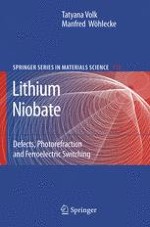2009 | OriginalPaper | Buchkapitel
Polarization Reversal and Ferroelectric Domains in LiNbO3 Crystals
Erschienen in: Lithium Niobate
Verlag: Springer Berlin Heidelberg
Aktivieren Sie unsere intelligente Suche, um passende Fachinhalte oder Patente zu finden.
Wählen Sie Textabschnitte aus um mit Künstlicher Intelligenz passenden Patente zu finden. powered by
Markieren Sie Textabschnitte, um KI-gestützt weitere passende Inhalte zu finden. powered by
Numerous publications on the polarization reversal and domain dynamics in LiNbO
3
and LiTaO
3
are summarized. First, the basics of the ferroelectric switching are discussed starting from the Landau-Guinzburg-Devonshire phenomenology with an account for a contribution from domains and domain walls. The concept of the internal bias fields
E
b
in ferroelectrics related to an interaction of defects with the host is presented. The Miller-Weinreich model of the ferroelectric switching is formulated and various techniques of studies in the ferroelectric switching and domain dynamics are drafted with an emphasis on those applicable to LiNbO
3
. The background part is closed by the basics of the optical frequency conversion using the ferroelectric domain structure. After a short historical review of the early results on the polarization reversal in LiNbO
3
and of the first attempts of the creation of periodically poled LiNbO
3
(PPLN), a specific of the ferroelectric
P-E
hysteresis loops in LiNbO
3
and LiTaO
3
is discussed. A drastic response of the coercive
E
c
and bias
E
b
fields and of the pulsed-switching parameters to an increase of the Li content or/and optical-damage-resistant impurity doping is described in detail. An interpretation of the polarization reversal specifics in terms of the pinning effects assuming the pinning centers to be the intrinsic defects is analyzed. In the next step an impact of a photoactive UV-light on the polarization reversal, particularly values of
E
c
and
E
b
and the switching velocity is presented which may be related to screening effects. In the end of the chapter, the experiments on recording regular domain patterns by means of electron and ion beams or under dc-voltages applied to AFM-tips are examined. These methods provide a possibility to obtain domain patterns on a nanoscopic level and to avoid the undesirable effects of back-switching and domain merging which are inherent for recording PPLNs by applying external fields to regular electrode patterns. A specific of the ferroelectric switching under an extremely spatially nonuniform field of an AFM-tip is characterized and current models are outlined.
